The term ‘carbohydrate’ (or saccharide which means sugar) comes from carbon, hydrogen, and oxygen-based molecules that are present in our foods, e.g., fruits and grains.
Unlike essential amino acids and fatty acids, there are no essential carbohydrates.
This means we can obtain everything we need nutritionally from other food sources, so carbs are not necessary to maintain life.
This has brought about much debate over the inclusion and requirement of carbohydrates in our daily diets and where they should fit into it. Some experts claim we do not need them in our diets, while others suggest they should never be excluded. As a result, we now have many different diet protocols based on how they manipulate carbohydrates in the body.
In this article you will learn about the different types of carbohydrates, their key roles in the body and recommended daily intakes for optimal health and performance.
Before digging in, as a valued reader of the blog, I’d like to extend you an invitation to our upcoming and totally FREE online training workshop:
‘The Proven Nutrition Strategies of Elite Trainers’.
This workshop is for you if you want to finally learn the best nutrition protocols and evidenced-based strategies to help your clients achieve life-changing results.
This workshop is our most complete training on how to make nutrition coaching easy and profitable.
All you need to do to attend is click here to register your free spot.

Dietary carbohydrate exists in three major classes: the monosaccharides, oligosaccharides, and polysaccharides. Within these three groups, we can further break down the categories into specific carbohydrate types:
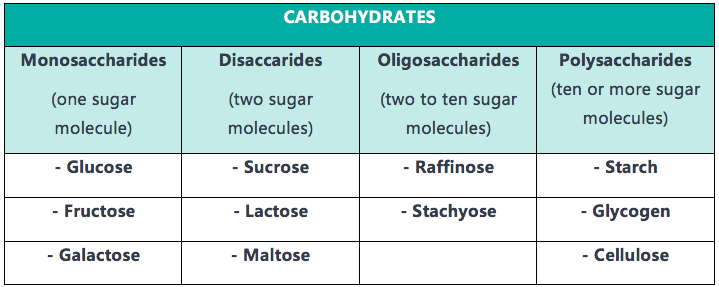
Note: the carbohydrates are grouped into these categories due to the variations in their molecular structure, i.e., 1-10+ molecules. This is why disaccharides are typically classified under oligosaccharides as they contain two particles.
Monosaccharides
This is the purest form of carbohydrate molecule, thus the term ‘mono,’ meaning they only contain one subunit of sugar.
The three most essential monosaccharides are glucose, fructose, and galactose. These are known as ‘simple’ carbohydrates and are recognized by their sweet taste.
Glucose is the body’s preferred type of carbohydrate and is usually the end product after the body digests the more complex carbohydrates. Glucose is what we measure in blood and therefore also serves as a transport molecule.
Glucose is therefore easily used by the body and is typically applied in the following 3 step process:
- Used for immediate energy,
- Stored within muscle or liver cells,
- Converted to triglycerides to be stored as body fat for later use.
Fructose is another monosaccharide that has to be metabolized within the liver for it to be converted to glucose. This is found in many natural and artificial foods and is considered the sweetest of the carbohydrates, hence the popularity in food manufacturing.
Over the years fructose has undergone a lot of debate, and it has therefore been covered in a separate article.
Oligosaccharides
When monosaccharides join together, they form disaccharides (2 molecule bonds) and oligosaccharides (2-10 molecule bonds). These then become ‘complex’ carbohydrates and are commonly found in 3 main carbohydrates types: sucrose, lactose, and maltose.
Sucrose is also known as table sugar and is, therefore, the most popular oligosaccharide. This carbohydrate occurs naturally in many of our foods (fruits, vegetables, beet sugar, cane sugar) and is essentially a combination of glucose and fructose.
Lactose is another common disaccharide yet it only exists in animal milk from lactating animals, and is a combination of glucose and galactose. The body requires a particular digesting enzyme called lactase to digest this type of carbohydrate.
The last important disaccharide is maltose, which is a combination of two glucose molecules. In nature, this occurs during the sprouting of seeds, but it can also be artificially induced (known as malting) by the introduction of heat. This process is usually seen in the production of alcohol, as they use this carbohydrate to provide that sweet taste in products.
Polysaccharides
The last of the saccharide categories are polysaccharides, meaning a bonding of 10 or more molecules to form linear or complex chains.
A homopolysaccharide is one that is made of 10 or more monosaccharides of the same type, e.g., all glucose. A heteropolysaccharide is one that is made of 10 or more monosaccharides from two or more different monosaccharide types, e.g., glucose and fructose.
When they are ‘branched,’ this means they are bonded. The image below summarises this information:
The last important monosaccharide is galactose. Just like fructose this carb molecule must be metabolized in the liver and will then be used in the same manner as glucose. Unlike the other two monosaccharides, galactose is not typically found alone in foods but joined with other molecules to form disaccharides.
These types of saccharides are typically found in animal and plant sources, and the two main groups of polysaccharides are starch and fiber.
Starches
The starch molecule is the storage form of carbohydrates in plants, e.g., grains, legumes, and potatoes. Within starch, you have two types: amylose and amylopectin.
Amylose is a linear chain containing hundreds of glucose units.
Amylopectin is a branched chain containing thousands of glucose units. Foods containing a high level of amylopectin tend to have a higher glycemic index, as they increase blood sugar levels the most due to their larger surface area available during digestion.
Starches that are not digested in the stomach (remain intact) are known as resistant starches, and may then be broken down in the gut to benefit gastrointestinal health. (1)
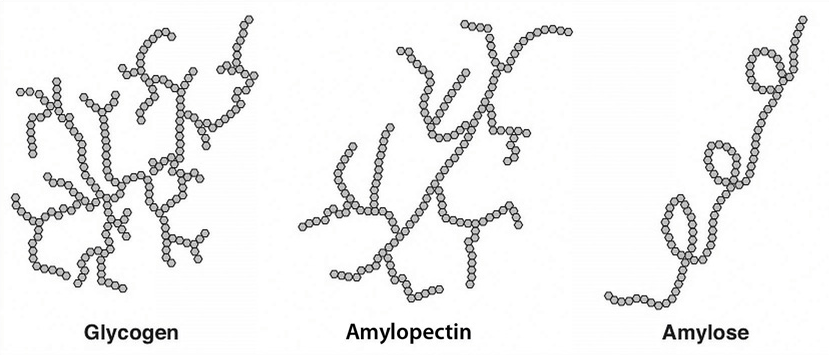
Note – Humans and animals store glucose energy from starches in the form of the large molecules, glycogen. This is typically stored in muscle and liver cells and provides quick energy due to its highly branched nature. This process is known as glycogenolysis.
Dietary Fibre
Fibre is considered a non-starch structural polysaccharide and examples are pectin, gum, and cellulose.
These fibres are found in plants, and despite the benefits to our health, they can only be broken down by the large intestine.
The Glycemic Index
The glycemic index or GI is a popular concept used to determine the effect of certain carbohydrates on blood sugar levels in the body. It, therefore, represents the metabolic response of the body to the carbohydrates we eat and is classified into 3 groups:
- Low GI foods = <55 GI value
- Medium GI foods = 56 – 69 GI value
- High GI foods = 70 or greater
Foods that have a low GI do not raise blood glucose levels as much, nor as fast as foods that have a high GI. The GI for a particular carbohydrate is primarily dependent on the rate at which the food is digested, thus resulting in how quickly glucose appears in the bloodstream.
The GI index ranking is based on a standard food such as white bread or pure glucose which is given the arbitrary glycemic index of 100. To work out the GI of a particular carbohydrate, the carbohydrates 2-hour glucose response curve is compared with 50g of carbs from the control food, i.e., white bread or glucose.
Many important factors will affect the digestion rate of a carbohydrate, namely: the type of carb, the amount, fibre content and proportion of other macronutrients present.
The initial decision to create the GI was based on the studies showing that we should be eating a diet in low GI foods to improve body composition and health. Recent research shows no correlation between the GI of a food and cardiovascular diseases, but it is a great tool to highlight how various carbohydrates will impact blood sugar levels and how the body may respond based on this. (2)
Below is a table listing common carbohydrates and their GI:
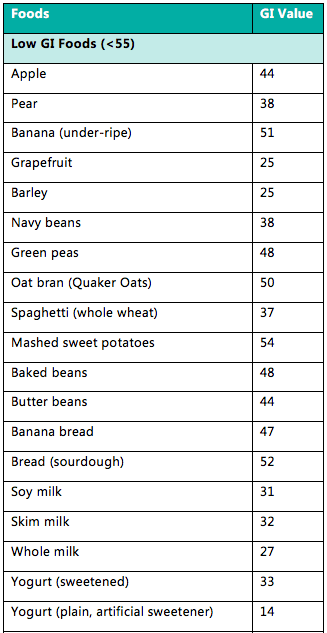

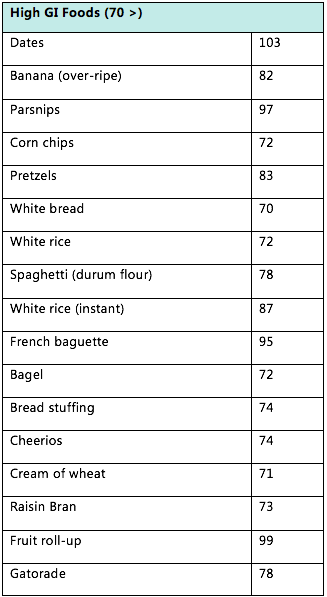
The Glycemic Load
The main problem with using the standard GI is that it only accounts for the type of carbohydrate and not the amount. Therefore the glycemic load or GL was introduced to represent the glycemic index and the carbohydrate content in a serving of carbs, thus representing the quality and quantity.
The ranking system works similar to the standard GI, as the higher the GL, the higher the expected increase in blood sugar levels.
The GL is calculated by multiplying the GI of a food by the grams of carbohydrates per serving size. Therefore foods with a higher amount of protein, fat or acidity, will help blunt the glucose response, improving blood sugar levels.
- Low GL = <10
- Medium GL = 11-19
- High GL = >20
Below is a table that shows some of the common foods that their respective glycemic load:
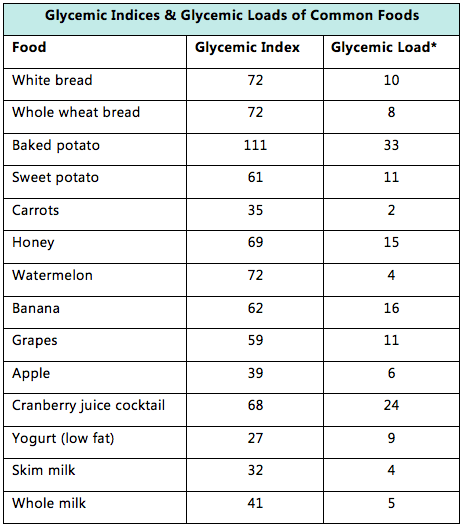
The Role of Carbohydrates
Although not essential in the diet, carbohydrates can have some critical functions to play:
- The primary source of energy for the body and brain
- Protein sparing and prevents ketosis
- Facilitates the body’s metabolism of fat
- Source of B vitamins for cholesterol metabolism
Type of carbohydrates chosen to determine:
Carbohydrate Metabolism
The metabolization of carbohydrates can be a very complex topic when examining it on a cellular level.
To simplify this, the cellular use of carbohydrates depends on their absorption from the gastrointestinal tract into the bloodstream.
To achieve this, all carbohydrates must be in the form of monosaccharides, so the body must break down polysaccharides and disaccharides through hydrolyzation before absorption can occur.
Carbohydrates can be metabolized by 2 different pathways:
- Anaerobic pathway (glycolysis and glycogenolysis)
- Aerobic pathway (oxidative)
Carbohydrate Requirements
There’s no precise definition of exactly how many carbs should make up someone’s diet, as what might be right for one person may not be for the next. An individual’s optimal intake depends on age, gender, body composition, activity levels, personal preference, food culture and current metabolic health.
When looking at the metabolic processes and their ability to supply energy for athletic performance, it is obvious that carbohydrates are an essential component of an athlete’s diet or nutrition for endurance atheletes.
Therefore, people who are physically active and have more muscle mass can tolerate a lot more carbohydrates than those who are sedentary. It’s essential as nutrition coaches to be aware of the amounts of carbohydrates in an active person’s diet, as it can have a significant impact on the glycogen stores and therefore athletic performance.
Metabolic health is also a significant factor, as, for those with metabolic syndrome, obesity or type II diabetes, the rules change significantly.
Those who fall into this category can’t tolerate the amount of carbohydrates as those who are healthy.
For those seeking fat loss and improved health (the majority improving their nutrition) a lower carbohydrate approach (meaning compared to the typical Western diet) appears to work well. (3) (4)
Studies show that low carbohydrate diets reduce appetite, meaning overall caloric intake is lowered. (5) Studies also show a low carbohydrate diet will provide better fat loss compared to low-fat dieting. (6) (7)
A low carbohydrate diet can also improve health markers such as lowering blood sugar, blood pressure, and triglycerides. (8) (9) (10)
General Recommendations of Average Intake
Note – these recommendations are not for those who are endurance or strength training, and this is covered in a separate article.
High Carb Diet – 200g+ per day
Some people do very well on a higher carb diet, and some of my clients can eat 300-400g per day while still losing body fat. Most are not so lucky, and those who can, usually follow into the same category – young, lean, active lifestyle and metabolically efficient.
If you do not tick all those boxes, the chances are you will not lose weight optimally eating this amount.
Moderate Carb Diet – 100-200g per day
This is a very common daily carb range for the majority of active and healthy people looking to cut the body fat. This still allows for some starch in the diet, yet limits the amount quite significantly.
You still get all the benefits of having carbs in the diet (so we feel good and perform well), yet lower the intake and overall amount to therefore optimize fat burning (to look good).
Low Carb Diet – <100g per day
This can be described as a ketogenic diet – one in which no starchy carbs (or very little) are consumed daily. This is when the body is forced to use fat for energy.
To do this, the person will go through a fat adaption phase, when the body releases ketones for muscle and brain fuel. This can be the most challenging part of such a diet as energy levels can significantly drop until this process is complete.
This energy slump is also typical for those transitioning from, for example, a high carb diet containing high sugar and processed foods to a moderate carb diet plan.
Most people lose weight quickly on this type of plan, but it suits those who are inactive, diabetic or seeking that last bit of fat loss. A low carb diet also works better with females, as they carry much less bodyweight than men, meaning they require less energy as a result.
The Magic 100
Without knowing or assessing someone, I typically suggest starting at 100g of carbohydrates (not including fibre) daily. This is a moderate amount of carbs for the majority of people and allows for ample amounts of starch too. It is in between a low and a high carb diet, and a good starting point for most to adjust as they need, based on results.
Adjustments should be gradual and calculated unless you have hugely over/underestimated their needs. Reduce or increase by 20-30g at a time.
Summary
You should now understand the importance of carbohydrate in the human diet, how it is metabolized, how to measure quality, assess daily intake for various populations, compare carbohydrate types and debunk some of the myths that surround it.
Become an elite-level nutrition coach
My team and I have just finished up creating a brand new online training workshop called 'The Proven Nutrition Strategies of Elite Trainers.'
Best part? It costs you nothing. This is your official invite - all you need to do to attend is click here to register.
This free nutrition course is for you if you want to finally learn the best nutrition protocols and evidenced-based strategies to help your clients achieve life-changing results.
Join me and I’ll walk you through the exact steps you need to take in order to get incredible client results, boost your confidence and build your business with proven nutrition coaching strategies.

